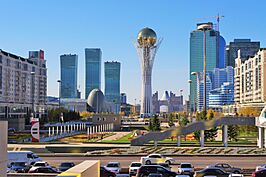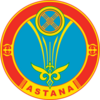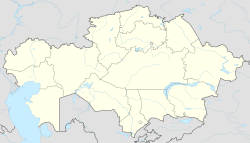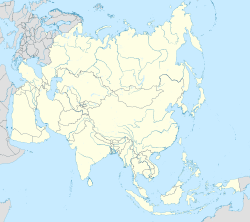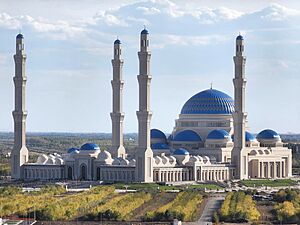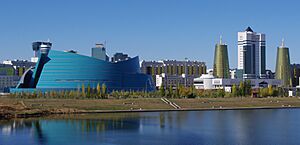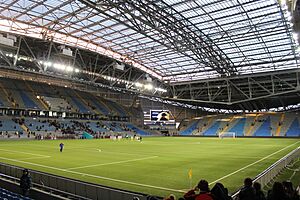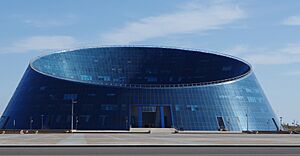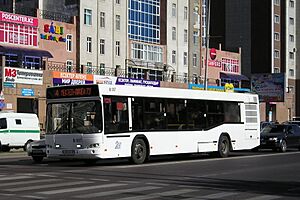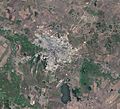Astana facts for kids
Quick facts for kids
Astana
Астана
|
|||
|---|---|---|---|
|
Capital city and city of republican significance
|
|||
|
Left to right, from the top:
Downtown Astana with Baiterek tower, Ishim River, Nurjol Boulevard, Nazarbayev University, L. N. Gumilyov Eurasian National University, and Astana Opera |
|||
|
|||
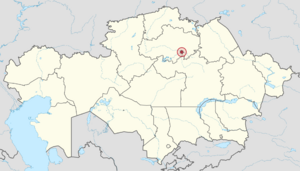 |
|||
| Country | |||
| Founded | 8th century (as Bozok) 1830 (modern settlement) |
||
| Government | |||
| • Type | Mayor–Council | ||
| • Body | City Mäslihat | ||
| Area | |||
| • City proper | 810.2 km2 (312.8 sq mi) | ||
| Elevation | 347 m (1,138 ft) | ||
| Population
(1 December 2023)
|
|||
| • City proper | 1,423,726 | ||
| • Density | 1,757.25/km2 (4,551.26/sq mi) | ||
| • Metro | 1,550,000 | ||
| GDP | |||
| • City proper | KZT 10,672 billion US$ 23.1 billion (2022) |
||
| • Per capita | KZT 8,053,900 US$ 17,443 (2022) |
||
| Time zone | UTC+05:00 (Kazakhstan Time) | ||
| • Summer (DST) | (Not Observed) | ||
| Postal code |
010000–010015
|
||
| Area code(s) | 7172 | ||
| HDI (2024) | 0.820 high · 5th |
||
| License plate | 01, Z | ||
Astana is the capital city of Kazakhstan. It was once known as Nur-Sultan, Akmolinsk, Tselinograd, and Akmola.
The city is located on the Ishim River in north-central Kazakhstan. It is part of the Akmola Region, but it has a special status and is managed separately. In 2022, Astana had about 1,350,228 people. This makes it the second-largest city in Kazakhstan, after Almaty. Astana became the capital in 1997. Since then, it has grown a lot and become one of the most modern cities in Central Asia. In 2021, the government chose Astana as a top place for tourists to visit.
Astana is a planned city, like many other capitals built for a specific purpose. After it became the capital, the city changed a lot. A famous Japanese architect named Kisho Kurokawa designed its main plan. Astana is where the government of Kazakhstan works. It has the Parliament House, the Supreme Court, the Ak Orda Presidential Palace, and many government offices. The city is known for its futuristic buildings, including many skyscrapers.
Contents
- City Names Through History
- Astana's History
- Astana's Geography
- People of Astana
- Astana's Economy
- Astana as a Diplomacy Hub
- City Layout
- Sports in Astana
- Education in Astana
- Transportation in Astana
- Expo 2017
- Places to See in Astana
- Theaters, Concert Halls, and Museums
- Sister Cities
- Smart City Initiatives
- Images for kids
- See also
City Names Through History
The settlement was first created in 1830 and was called Akmoly. This name might come from the Kazakh words for "white grave." In 1832, it became a town and was renamed Akmolinsk.
In 1961, the city was renamed Tselinograd. This Russian name means "City of Virgin Lands." It was given this name because of a big farming project in the area. After Kazakhstan became independent in 1991, the name was changed back to Akmola.
In December 1997, Akmola became the new capital of Kazakhstan, replacing Almaty. In May 1998, its name was changed to Astana, which means "capital city" in Kazakh. In March 2019, the capital was renamed Nur-Sultan. This was to honor the country's first president, Nursultan Nazarbayev, after he stepped down. However, in September 2022, the name was changed back to Astana. Astana holds a Guinness World Record for being the capital city with the most name changes in modern times.
Astana's History
Early Times (8th to 18th centuries)
Many centuries ago, a settlement called Bozok existed where Astana is now. It was a military fort along the Great Silk Road. The name "Boz" means 'untouched earth' or 'virgin soil'. It was a large settlement between the 12th and 14th centuries. Today, Astana is growing into the area where ancient Bozok once stood.
Founding and Growth (1830–1918)
The settlement of Akmoly was started in 1830 on the Ishim River. In 1832, it became a town called Akmolinsk. Its location was very good because it connected to other important places. In 1838, during a big national movement, the Akmolinsk Fortress was burned down. It was later rebuilt. In 1869, Akmolinsk became the center of a new region called Akmolinsk Oblast.
At first, Akmola had only about 2,000 people. But over the next 30 years, its population grew three times larger. By 1893, Akmolinsk had 6,428 people, several churches, schools, and factories.
Soviet Era (1918–1991)
During World War II, Akmolinsk was important for moving tools and equipment from factories in other parts of the Soviet Union. Local industries helped provide materials for the war. After the war, Akmolinsk helped the Soviet Union recover economically. Many Russian-Germans were also moved here.
In 1954, the northern parts of Kazakhstan became part of the Virgin Lands Campaign. This was a big project to grow more grain for the Soviet Union. In 1961, Akmolinsk was renamed Tselinograd, meaning "City of Virgin Lands." The city changed a lot in the 1960s. New tall buildings, a palace, an airport, and sports venues were built.
Modern Astana (1991–Present)
After the dissolution of the Soviet Union in 1991, Kazakhstan became independent. The city's name was changed back to Akmola. On December 10, 1997, the capital of Kazakhstan moved from Almaty to Akmola. In 1998, the city was renamed Astana. Astana was chosen as the capital for many reasons. It had large areas for building, a good location, and was close to important economic centers. It also had good transportation.
In July 1999, UNESCO gave Astana the medal and title of "City of Peace." In March 2019, the city was briefly renamed Nur-Sultan to honor the former president. But in September 2022, after some events, the name was changed back to Astana.
Astana's Geography
Astana is about 1,000 km (620 mi) from Almaty, the country's largest city. Nearby big cities include Karaganda (200 km (120 mi)) and Omsk in Russia (450 km (280 mi)).
Land and Location
Astana is in central Kazakhstan, on the Ishim River. It is in a very flat, dry grassland area called the steppe. The city covers about 722.0 square kilometres (278.8 sq mi). Astana is 347 metres (1,138 ft) above sea level. The older parts of the city are north of the river, while the newer parts are to the south.
Time Zone
Astana uses UTC+5:00. This means it is 5 hours ahead of UTC.
Climate
Astana is the second-coldest national capital in the world, after Ulaanbaatar, Mongolia. It has an extreme continental climate. This means it has warm summers with some rain and long, very cold, dry winters. Summer temperatures can reach 35 °C (95 °F). In winter, temperatures of −30 to −35 °C (−22 to −31 °F) are common from mid-December to early March. The Ishim River is usually frozen from November to April. Astana is also known for its strong winds.
The average yearly temperature in Astana is 3.9 °C (39.0 °F). January is the coldest month, with an average of −14.5 °C (5.9 °F). The coldest temperature ever recorded was −51.6 °C (−60.9 °F) in January 1893. July is the hottest month, with an average of 20.6 °C (69.1 °F).
People of Astana
| Historical population | ||
|---|---|---|
| Year | Pop. | ±% |
| 1989 | 281,252 | — |
| 1999 | 326,900 | +16.2% |
| 2002 | 493,100 | +50.8% |
| 2010 | 649,139 | +31.6% |
| 2016 | 872,655 | +34.4% |
| 2020 | 1,136,008 | +30.2% |
Population Growth
As of January 2020, Astana's population was 1,136,008. This is more than double its population in 2002. In 2017, the city reached over 1 million people. Many people, including young professionals, have moved to Astana from other parts of Kazakhstan and nearby countries.
Ethnic Groups
In 2018, Kazakhs made up 80.6% of the city's population. This is a big increase from only 17% when Kazakhstan became independent.
Ethnic groups in 2020:
- Kazakh: 79.1%
- Russian: 12.85%
- Ukrainian: 1.32%
- Tatar: 1.08%
- Uzbek: 0.96%
- Others: 4.65%
Religions
| Religion in Astana (2021) | ||||
|---|---|---|---|---|
| Religion | Percent | |||
| Islam | 78.48% | |||
| Christianity | 10.99% | |||
| Other religions | 0.30% | |||
| Atheism | 2.31% | |||
| Undeclared | 7.92% | |||
The main religions in Astana are Islam and Christianity. Christianity includes Russian Orthodoxy, Roman Catholicism, and Protestantism. Other religions like Judaism, Lutheranism, and Buddhism are also practiced.
The Palace of Peace and Reconciliation was built in 2006 to host meetings of world religious leaders. It has places for different religions, including Judaism, Islam, Christianity, Buddhism, Hinduism, and Taoism. Astana is home to Central Asia's largest mosque and Central Asia's largest synagogue.
Metropolitan Area
The area around Astana, called the metropolitan area, includes parts of the Akmola Region. About 1.2 million people live in this larger area.
Astana's Economy
Astana's economy relies on trade, making things (industrial production), transport, communication, and construction. The city mainly produces building materials, food, and mechanical engineering products.
Astana is an important center for the Belt and Road Initiative. This is a huge project to connect countries through trade and infrastructure. Astana is a leader in financial services in the CIS region. The Astana International Financial Center (AIFC) opened in 2018. It aims to be a financial hub for Central Asia.
Many state-owned companies have their main offices in Astana. These include big companies like Kazakhstan Temir Zholy (railways) and KazMunayGas (oil and gas).
Becoming the capital greatly boosted Astana's economy. The city's fast growth has attracted many investors. In 16 years, investments increased almost 30 times. The city's total economic output grew 90 times, and industrial production increased 11 times. Astana's economy makes up about 8.5% of Kazakhstan's total economy.
A special economic zone called Astana – New City was created in 2001. This helps develop industries and attract more investors. The city also supports small and medium-sized businesses. This has led to a big increase in the number of such businesses and the people they employ.
In 2016, Astana was named one of the top 21 "intelligent communities" in the world. This means it uses digital tools to improve its economy and society. In 2018, Astana attracted over US$7.91 billion in foreign investment, a record for the city. This was partly due to many construction projects. Tourism is also becoming a key part of Astana's economic growth.
Astana as a Diplomacy Hub
Astana has become a place for important international meetings and talks. It has hosted discussions between the Syrian government and the Syrian opposition. The city was also supposed to host a big meeting of the World Trade Organization (WTO) in 2020, but it was postponed. Since 2003, Astana has hosted the Congress on World and Traditional Religions. This event brings together religious leaders to talk about peace and fighting extremism.
City Layout
Astana is divided into four main areas or districts: Almaty District, Yesil District, Saryarka District, and Baykonyr District.
In 1998, the Government of Kazakhstan held a competition for architects to design the new capital. Japanese architect Kisho Kurokawa won. His plan was to keep and improve the old city while building a new city on the south and east sides of the Ishim River. This was meant to blend history with the future.
North of the railway line, you'll find industrial areas and older homes. Between the railway line and the Ishim river is the city center, which is currently seeing a lot of new construction. To the west and east are newer residential areas with parks. South of the Ishim River is where many government buildings and diplomatic areas are being built. Astana's main planner wants to create a city that feels like a "Berlin in a Eurasian style," not just an administrative capital like Canberra.
Two important buildings in Astana are the Palace of Peace and Reconciliation and the Khan Shatyr Entertainment Center. Their designs are inspired by the ancient nomadic empires of the Eurasian steppes.
Sports in Astana
Astana has many sports teams. The main association football team is FC Astana. They play in the Kazakhstan Premier League and have won many titles. Their home stadium is the Astana Arena. This stadium is also home to the Kazakhstan national football team.
Astana also has several professional ice hockey teams. The Barys Astana plays in the Kontinental Hockey League. The Nomad Astana and HC Astana play in the Kazakhstan Hockey Championship. Astana hosts an annual ice hockey tournament called the President of the Republic of Kazakhstan's Cup.
The Astana Pro Team is a professional road cycling team that competes in the UCI World Tour. They have won several major races. The BC Astana is the city's professional basketball team. They are the most successful basketball team in Kazakhstan. Their home arena is the Saryarka Velodrome, which is mainly used for track cycling. The 2011 Asian Winter Games were partly held in Astana. The Alau Ice Palace hosted the 2015 World Sprint Speed Skating Championships for speed skating. The President's Cup tennis tournament is held every year at the Daulet National Tennis Centre.
A large martial arts palace opened in 2019. It can host international competitions for sports like boxing, wrestling, judo, and weightlifting. It also has a swimming pool, fitness rooms, a football field, and a hotel.
Education in Astana
Astana has many universities and colleges. In the 2013/2014 school year, over 53,000 students were enrolled in 14 higher education schools. The L.N.Gumilyov Eurasian National University is the largest university in Astana. It has over 16,000 students. The oldest university is the S. Seifullin Kazakh Agro Technical University, founded in 1957. Nazarbayev University is a research university that opened in 2010. Other important schools include the Kazakh University of Economics, Finance and International Trade, and the Astana Medical University. The Kazakh National University of Arts trains professionals in the arts.
Astana has about 103,000 students in 83 schools, including state and private schools. The Miras International School was the first private high school in Astana, opened in 1999. Haileybury Astana is a branch of a famous school from the United Kingdom. There are also Kazakh-Turkish High Schools and the Nurorda International School. Astana has two Nazarbayev Intellectual Schools, which are known for their special programs. The QSI International School of Astana offers an American curriculum.
Transportation in Astana
City Transport
People in Astana use buses and taxis to get around. More than 720,000 people use public transport every day. There are over 60 bus lines with more than 1,000 buses. Share taxis also follow set routes.
Trolleybus routes used to operate in the city but were closed in 2008. In 2011, Astana started plans for a "New transport system." This included bus rapid transit (BRT) lines. Construction for a light rail (LRT) system began in 2017. After some delays, construction restarted in 2023, and the LRT is expected to open in 2024-25.

The AstanaBike bicycle-sharing system started in 2014. By 2017, it had 40 stations and 1,000 bicycles. Renting a bike for the first half-hour is free.
Air Travel
Nursultan Nazarbayev International Airport (NQZ) is the main airport for Astana. It is about 17 kilometres (11 mi) southeast of the city center. It is the second-busiest airport in Kazakhstan, with 7.5 million passengers in 2023. Many airlines fly from here, both within Kazakhstan and to other countries. Air Astana has a major hub at this airport. A new terminal was built to handle more passengers.
Trains and Roads
Astana is in the center of Kazakhstan, making it a good hub for train and road networks. Astana railway station is the city's main train station, serving about 7,000 people daily. A new station, Nurly Zhol, was built for Expo 2017 and can handle 12,000 passengers. The Tulpar Talgo is a daily express train to Almaty. Major highways like M-36 Chelyabinsk-Almaty and A-343 Astana-Petropavlovsk pass through the city.
River Transport
Since 2008, boats have been used on the Esil River within the city. This was part of a program to organize river transport.
Expo 2017
On July 1, 2010, Astana presented its plan to host the Specialised Expo 2017. The theme for Astana Expo was "Future Energy." This focused on how energy affects society.
Expo 2017 opened on June 10, 2017, with leaders from many countries attending. It was the first world's fair held in Central Asia. Its main building, Nur Alem, is the largest spherical building in the world. More than 4 million people visited the event.
Places to See in Astana
- Akorda is the official home of the President of the Republic of Kazakhstan.
- Astana Grand Mosque is the largest mosque in Central Asia, finished in 2022.
- Baiterek is a famous monument and symbol of Astana.
- "Ethnoaul National Cultural Complex" lets visitors experience the history, culture, and traditions of the Kazakh people. You can feel like a nomad from centuries ago.
- Gate of Eternal Land is a landmark built to celebrate Kazakhstan's independence.
- Independence Palace is a building for international events. It also has a large model of Astana.
- "Jastar" is a palace for creativity for students and young people.
- Kazakh Eli is a monument on Independence Square. It has a 91-meter tall pillar with the Samruk bird on top. The Samruk bird is a mythical bird that spreads seeds of life.
- "Kazakhstan" is the Central Concert Hall.
- Khan Shatyr is a huge shopping and entertainment center. It is considered the largest tent in the world and was designed by Norman Foster.
- Kazakhstan Pavilion of Expo 2017:
- Kazakhstan Pavilion and Science Museum "Nur Alem" is the tallest spherical building. It is 100 meters high and 80 meters wide.
- National Space Center Future Energy Museum "Nur Alem" EXPO 2017 focuses on future energy. You can learn about renewable and green energy sources.
- Nurjol Boulevard (formerly Water-Green Boulevard) is a walking area with singing fountains.
- Palace of Peace and Reconciliation is a Congress Hall designed for meetings of religious leaders. It was designed by Norman Foster.
- Shabyt Palace is home to the Kazakh National University of Arts.
Theaters, Concert Halls, and Museums
Astana has 27 libraries, 8 state museums, 10 parks, and 6 cinemas.
- The Central Concert Hall Kazakhstan is a special building for concerts, celebrations, and meetings. It was designed by Manfredi Nicoletti.
- Astana Circus is one of the main circuses in Kazakhstan. It has a unique "flying saucer" shape.
- The National Opera and Ballet Theater named after K. Baiseitova is a young musical theater that performs Kazakh and world music.
- Astana Opera is a theater started by the first president of Kazakhstan. The building, built in 2013, is a beautiful architectural landmark.
- Kazakh Music and Drama Theater named after K. Kuanyshbaev.
- State Academic Russian Drama Theater named after Maxim Gorky.
- The National Museum of the Republic of Kazakhstan is the largest museum in Central Asia.
- Modern Art Museum.
- Presidential Center of Culture includes a museum, a library, and a concert hall.
- ALZhIR (Akmola camp of wives of traitors to the motherland) was a large Soviet women's camp.
- Atameken is a complex with a large map of Kazakhstan showing its nature, architecture, and life.
- Museum of the First President of the Republic of Kazakhstan.
- Memorial complex of the Ministry of Internal Affairs (honoring heroes of World War II).
- Museum of The Future (Nur-Alem Pavilion) is part of Expo 2017. It teaches about future energy, including renewable and solar power.
Sister Cities
Astana is connected with many cities around the world. These are called "sister cities" or "twin towns."
 Amman, Jordan (2005)
Amman, Jordan (2005) Ankara, Turkey (2001)
Ankara, Turkey (2001) Ashgabat, Turkmenistan (2017)
Ashgabat, Turkmenistan (2017) Bangkok, Thailand (2004)
Bangkok, Thailand (2004) Beijing, China (2006)
Beijing, China (2006) Bishkek, Kyrgyzstan (2011)
Bishkek, Kyrgyzstan (2011) Damascus, Syria
Damascus, Syria Gdańsk, Poland (1996)
Gdańsk, Poland (1996) Hanoi, Vietnam (2009)
Hanoi, Vietnam (2009) Islamabad, Pakistan
Islamabad, Pakistan Kazan, Russia (2004)
Kazan, Russia (2004) Kyiv, Ukraine (1998)
Kyiv, Ukraine (1998) Manila, Philippines
Manila, Philippines Moscow, Russia
Moscow, Russia Nice, France (2013)
Nice, France (2013) Nusantara, Indonesia (2023)
Nusantara, Indonesia (2023) Oulu, Finland (2013)
Oulu, Finland (2013) Putrajaya, Malaysia
Putrajaya, Malaysia Riga, Latvia (1998)
Riga, Latvia (1998) Saint Petersburg, Russia (1996)
Saint Petersburg, Russia (1996) Seoul, South Korea (2004)
Seoul, South Korea (2004) Tashkent, Uzbekistan
Tashkent, Uzbekistan Tbilisi, Georgia (1996)
Tbilisi, Georgia (1996) Ufa, Russia (2010)
Ufa, Russia (2010) Ulaanbaatar, Mongolia (2019)
Ulaanbaatar, Mongolia (2019) Uşak, Turkey
Uşak, Turkey Vilnius, Lithuania
Vilnius, Lithuania Warsaw, Poland (2002)
Warsaw, Poland (2002) Zagreb, Croatia (2014)
Zagreb, Croatia (2014)
Friendly Cities
Astana also works closely with these cities:
Smart City Initiatives
The Smart Astana project uses technology to improve different parts of the city. This includes hospitals, schools, ticket booking, and street lighting. These projects are connected through a special application called Smart Astana.
Astana also hosts the Astana Innovations Challenge every year. This event helps bring attention to the idea of a "smart city." The world's first "smart sustainable city acceleration hub" is also planned to open in Astana. This hub will help new tech ideas become part of Kazakhstan's city life.
Images for kids
See also
 In Spanish: Astaná para niños
In Spanish: Astaná para niños


